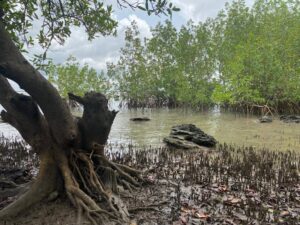Séminaire
Séminaire de Sarma V.V.S.S. (National Institute of Oceanography, Visakhapatnam, India): Role of anthropogenic nitrogen in modifying estuarine ecosystems and the northern Indian Ocean
Sarma V.V.S.S.
Sarma V.V.S.S. is an oceanographer at the National Institute of Oceanography in Visakhapatnam, India, and will be giving a seminar on the role of anthropogenic nitrogen in modifying estuarine ecosystems and the northern Indian Ocean on the 15th of November at 2p.m.
Description
A significant amount of anthropogenic nitrogen is released to the environment (atmosphere, lithosphere and hydrosphere) through different sectors (agriculture, industrial and domestic) and their impact on the plankton ecosystem is unclear. India is the second-largest fertilizer-consuming country in the globe, after China, and it is hypothesized that the excess fertilizer used in the agricultural forms may be fluxed to the coastal ocean leading to the formation of eutrophication and hypoxia. On the other hand, the atmospheric pollution over south and Southeast Asia, including India, is the highest over the globe. The major contributors of atmospheric inorganic pollutants are nitrate and sulphate which contribute up to 50% of total water-dissolvable inorganic salts. Their possible impact on ocean acidification and primary production is unclear. For the past 5 years, we made extensive work on the role of anthropogenic nitrogen on ocean acidification, denitrification, primary production and ecosystem modification in the estuaries, groundwater and the northern Indian Ocean through observations, experiments, remote sensing and numerical modelling.
Our research revealed that fertilizer nitrogen is not fluxed into the coastal waters but they accumulate in the groundwater where extensive denitrification occurs. The deposition of atmospheric pollutants, mainly nitrates and sulphate and organic acids, decreases the pH of the surface waters leading to rapid acidification, which is 3 times higher than elsewhere in the globe in the same latitudinal belt. On the other hand, atmospheric deposition of nitrate and ammonium also enhances primary production and modifies the phytoplankton composition through changes in the N stoichiometry. In addition, the atmospheric pollutants decrease air temperature which leads to an increase in the winter convective mixing and an increase in nutrients and the formation of Noctiluca Harmful Algal Blooms. Based on the available nitrogen data in the atmospheric aerosols, and remote sensing aerosol optical depth, the spatial variability in inorganic nitrogen and their possible depositional rates were derived over the northern Indian Ocean. The inclusion of atmospheric contribution in the numerical models may further enhance our understanding of variability in ocean ecosystems due to climate change.
Informations supplémentaires
Date & Time: Tue Nov 15 2022 14:00:00 GMT+0100 (Central European Standard Time)
Room: Tower 45/55 4th floor, room 417
Online: https://sciencespo.zoom.us/j/7460198974
Meeting ID : 746 019 8974
For any questions regarding the seminar please contact Lester Kwiatkowski () or Casimir de Lavergne ()






